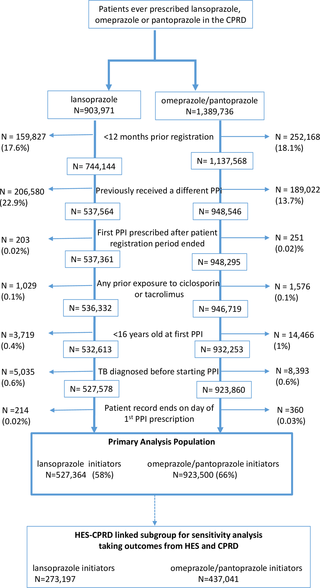PLOS Medicine ( IF 10.5 ) Pub Date : 2017-11-21 , DOI: 10.1371/journal.pmed.1002457 Tom A Yates 1 , Laurie A Tomlinson 2 , Krishnan Bhaskaran 2 , Sinead Langan 2 , Sara Thomas 2 , Liam Smeeth 2 , Ian J Douglas 2

|
Background
Recent in vitro and animal studies have found the proton pump inhibitor (PPI) lansoprazole to be highly active against Mycobacterium tuberculosis. Omeprazole and pantoprazole have no activity. There is no evidence that, in clinical practice, lansoprazole can treat or prevent incident tuberculosis (TB) disease.
Methods and findings
We studied a cohort of new users of lansoprazole, omeprazole, or pantoprazole from the United Kingdom Clinical Practice Research Datalink to determine whether lansoprazole users have a lower incidence of TB disease than omeprazole or pantoprazole users. Negative control outcomes of myocardial infarction (MI) and herpes zoster were also studied. Multivariable Cox proportional hazards regression was used to adjust for potential confounding by a wide range of factors. We identified 527,364 lansoprazole initiators and 923,500 omeprazole or pantoprazole initiators. Lansoprazole users had a lower rate of TB disease (n = 86; 10.0 cases per 100,000 person years; 95% confidence interval 8.1–12.4) than omeprazole or pantoprazole users (n = 193; 15.3 cases per 100,000 person years; 95% confidence interval 13.3–17.7), with an adjusted hazard ratio (HR) of 0.68 (0.52–0.89). No association was found with MI (adjusted HR 1.04; 95% confidence interval 1.00–1.08) or herpes zoster (adjusted HR 1.03; 95% confidence interval 1.00–1.06). Limitations of this study are that we could not determine whether TB disease was due to reactivation of latent infection or a result of recent transmission, nor could we determine whether lansoprazole would have a beneficial effect if given to people presenting with TB disease.
Conclusions
In this study, use of the commonly prescribed and cheaply available PPI lansoprazole was associated with reduced incidence of TB disease. Given the serious problem of drug resistance and the adverse side effect profiles of many TB drugs, further investigation of lansoprazole as a potential antituberculosis agent is warranted.
中文翻译:

英国临床实践研究数据链中兰索拉唑的使用和结核病发病率:基于人群的队列
背景
最近的体外和动物研究发现,质子泵抑制剂 (PPI) 兰索拉唑对结核分枝杆菌具有高度活性。奥美拉唑和泮托拉唑没有活性。没有证据表明,在临床实践中,兰索拉唑可以治疗或预防偶发性结核病 (TB)。
方法和发现
我们研究了来自英国临床实践研究数据链的一组兰索拉唑、奥美拉唑或泮托拉唑新使用者,以确定兰索拉唑使用者的结核病发病率是否低于奥美拉唑或泮托拉唑使用者。还研究了心肌梗塞 (MI) 和带状疱疹的阴性对照结果。多变量 Cox 比例风险回归用于调整各种因素的潜在混杂因素。我们确定了 527,364 种兰索拉唑引发剂和 923,500 种奥美拉唑或泮托拉唑引发剂。兰索拉唑使用者的结核病发病率(n = 86;每 10 万人年 10.0 例;95% 置信区间 8.1-12.4)低于奥美拉唑或泮托拉唑使用者(n= 193; 每10万人年15.3例;95% 置信区间 13.3–17.7),调整后的风险比 (HR) 为 0.68 (0.52–0.89)。未发现与 MI(调整后的 HR 1.04;95% 置信区间 1.00-1.08)或带状疱疹(调整后的 HR 1.03;95% 置信区间 1.00-1.06)相关。这项研究的局限性在于,我们无法确定结核病是由于潜伏感染的重新激活还是近期传播的结果,我们也无法确定兰索拉唑是否会对患有结核病的人产生有益的影响。
结论
在这项研究中,使用常用处方且价格低廉的 PPI 兰索拉唑与降低结核病发病率有关。鉴于耐药性的严重问题和许多结核病药物的不良副作用特征,有必要对兰索拉唑作为潜在的抗结核药物进行进一步研究。











































 京公网安备 11010802027423号
京公网安备 11010802027423号